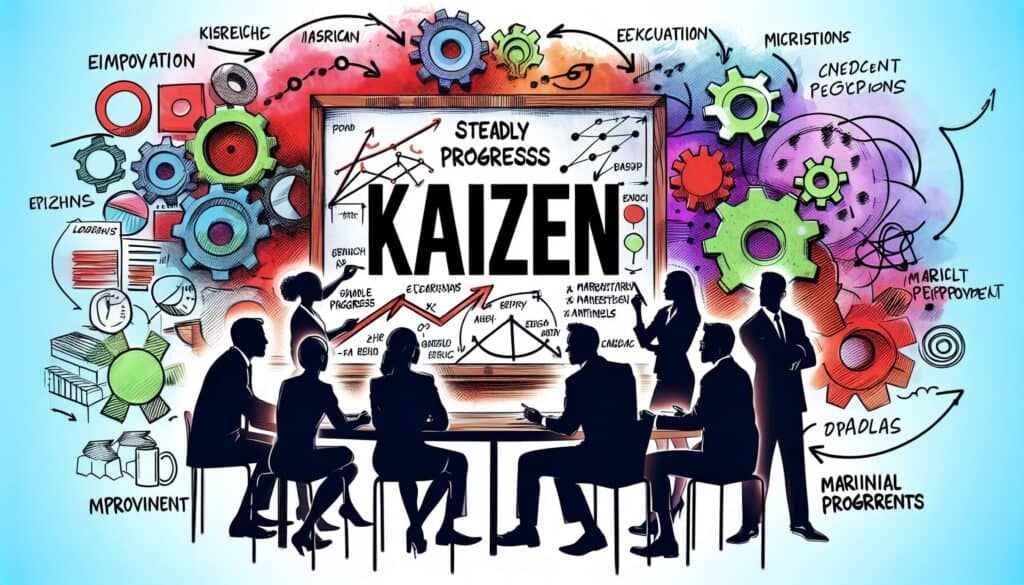A philosophy and practice of making ongoing, incremental improvements to processes, products, and services, involving everyone in an organization.
- Methodologies: Engineering, Quality
Kaizen (Continuous Improvement)

Kaizen (Continuous Improvement)
- Continuous Improvement, Kaizen, Lean Manufacturing, Plan–Do–Check–Act (PDCA), Process Improvement, Process Optimization, Quality Assurance, Quality Management
Objective:
How it’s used:
- Involves regular, small-scale improvement activities (e.g., Kaizen events or Blitzes, suggestion systems) where teams identify waste or inefficiencies, brainstorm solutions, implement changes, and standardize successful improvements. Focuses on PDCA cycles.
Pros
- Promotes a culture of continuous learning and employee engagement; Leads to gradual but significant long-term improvements; Low cost, often focusing on creativity over capital investment; Improves efficiency and reduces waste.
Cons
- Requires strong management commitment and supportive culture; Can be slow to achieve radical changes if only small steps are taken; Sustaining momentum can be challenging; May faceresistance from employees accustomed to traditional ways.
Categories:
- Ideation, Lean Sigma, Manufacturing, Problem Solving, Project Management, Quality
Best for:
- Fostering a culture of ongoing, incremental improvements across all aspects of an organization to enhance quality, efficiency, and employee satisfaction.
Kaizen is frequently applied across various industries including manufacturing, healthcare, and service sectors, where continuous improvement can significantly enhance operational effectiveness. During the development phase of a product, teams can initiate Kaizen events or Blitzes, bringing together cross-functional groups to identify specific areas of waste or inefficiency within processes. For instance, in a manufacturing setting, Kaizen might focus on optimizing assembly line procedures through small adjustments that minimize downtime or eliminate redundant steps. Healthcare facilities often employ Kaizen to improve patient flow and resource allocation, allowing staff to devise solutions that enhance care delivery without necessitating substantial budget increases. Participating team members may include engineers, quality control experts, frontline staff, and management, all of whom contribute their unique perspectives and expertise to the problem-solving process. The use of PDCA (Plan-Do-Check-Act) cycles enables teams to systematically implement improvements, monitor the impact, and standardize successful changes. These methodologies can lead to a culture where employees feel empowered to suggest ongoing refinements, ultimately engendering a sense of ownership and commitment to achieving excellence within the organization. As improvements accumulate over time, the results can transform operational capabilities, increase customer satisfaction, and promote a sustainable environment where continuous learning becomes integral to the organization’s ethos.
Key steps of this methodology
- Identify areas of improvement through collaboration and observation.
- Brainstorm potential solutions for identified inefficiencies.
- Implement selected improvements on a small scale or in pilot tests.
- Standardize successful changes to ensure consistent application.
- Review the effects of implemented changes and gather feedback.
- Repeat the cycle to continuously seek further enhancements.
Pro Tips
- Incorporate cross-functional teams in Kaizen events to leverage diverse perspectives and enhance problem-solving capabilities.
- Use data analytics to identify specific areas of waste and inform decision-making during improvement initiatives.
- Establish a robust feedback loop post-implementation to evaluate the long-term impact of changes and continually refine processes.
To read and compare several methodologies, we recommend the
> Extensive Methodologies Repository <
together with the 400+ other methodologies.
Your comments on this methodology or additional info are welcome on the comment section below ↓ , so as any engineering-related ideas or links.
Historical Context
1950
1980
1980
1986
1994
1995
2000
1960
1980
1983
1990
1995
2000
2010
(if date is unknown or not relevant, e.g. "fluid mechanics", a rounded estimation of its notable emergence is provided)














Related Posts
Manufacturing Operations Management (MOM)
Manufacturing Execution System (MES)
Manufacturing Control Plan
Manual Testing
Manual Handling Assessment Charts (MAC)
ManTRA (Manual Tasks Risk Assessment Tool)